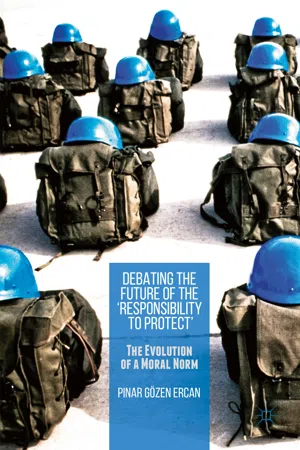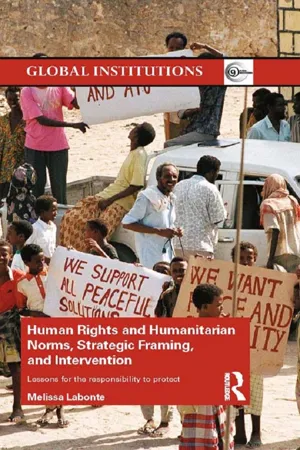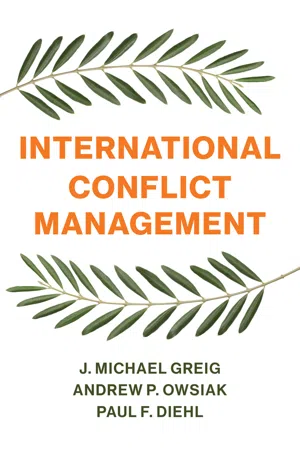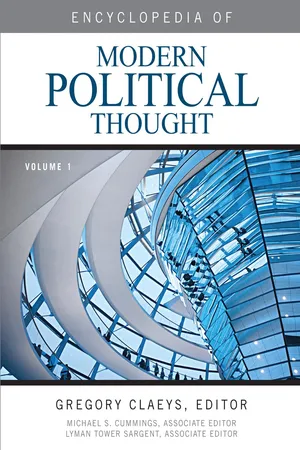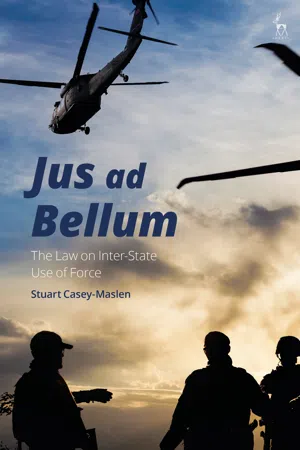Humanitarian Intervention
Humanitarian intervention refers to the use of military force or other forms of intervention by external actors to protect individuals from gross and systematic violations of their human rights. It is often justified on moral grounds and aims to alleviate human suffering. However, it is a controversial concept due to concerns about sovereignty, legitimacy, and the potential for abuse.
6 Key excerpts on "Humanitarian Intervention"
- eBook - ePub
Debating the Future of the 'Responsibility to Protect'
The Evolution of a Moral Norm
- Pinar Gözen Ercan(Author)
- 2016(Publication Date)
- Palgrave Macmillan(Publisher)
...In this book, Humanitarian Intervention is defined as the use of military means ‘across state borders’ by a state, a group of states, or an international and/or regional organisation (Abiew 1998, p. 18) in order to prevent or halt ‘widespread and grave violations of the fundamental human rights of individuals other than […the intervener(s)’s] own citizens’ (Holzgrefe and Keohane 2003, p. 18), with or without the consent of the target state that is subjected to the use of force in its own territory as a result of the intervention. This definition excludes acts that historically and legally fall under self-defence, which is observed in the protection of nationals in a third state. Humanitarian Intervention is an act of coercive protection through use of force due to extreme circumstances concerning the violation of fundamental human rights of masses. Responsibility versus Right? Price (2008, p. 215) argues that ‘dilemmas only arise if norms are social facts. Progress may well be had, and even though it may be at the price of the generation of yet new dilemmas, this in itself points to a different ethic than that premised on world politics as a realm of recurrence and repetition devoid of possibilities of humanitarian moral change’. From a constructivist point of view, the challenges the international community faces contribute to the emergence of new norms. Arguably, it was the human rights crises of the 1990s that led to the construction of R2P. In responding to mass atrocities against humanity, Humanitarian Intervention remained a relevant foreign policy tool while its implementation has been a source of moral and legal divides within the international community...
- eBook - ePub
Human Rights and Humanitarian Norms, Strategic Framing, and Intervention
Lessons for the Responsibility to Protect
- Melissa Labonte(Author)
- 2013(Publication Date)
- Routledge(Publisher)
...In other cases, strategic national interest may compel it. When the greatest danger a civilian population faces comes from its own government, a pressing dilemma of international politics is whether people in such danger should be rescued by military forces from outside. 5 While the tension between sovereignty and human rights sits at the heart of the debate over the legitimacy and legality of contemporary Humanitarian Intervention, the ascendance of liberalism during the latter half of the twentieth century brought with it the expansion of commitments to individuals as both subjects and objects under international law, especially in the realm of human rights. The obligations states have to others outside their borders, the individual accountability of perpetrators of mass atrocity crimes (including sitting leaders), and shifts in the absolute nature of territorial (or national) sovereignty have all contributed to what is an unsettled debate concerning the use of military force for humanitarian protection purposes. The moral foundations of Humanitarian Intervention are said to have been established before the birth of Christ in the era of St Ambrose, who claimed “fulsome is the justice that protects the frail.” 6 Humanitarian Intervention also featured prominently in medieval Christian theology and politics, and has close links to the Just War tradition. 7 Prior to the Second World War, customary international law provided the precedent to justify Humanitarian Intervention, thus permitting states to “intervene in situations where another state mistreated its own citizens in a way falling so far below the ‘general standards recognized by civilized peoples’ as to ‘shock the conscience of mankind.’” 8 However, the potential for abuse of the norm led policy makers to oppose any emerging doctrine of Humanitarian Intervention. While forming a bedrock principle of the post-Westphalian global order, sovereignty has never truly been inviolable or sacrosanct...
- eBook - ePub
- J. Michael Greig, Andrew P. Owsiak, Paul F. Diehl(Authors)
- 2019(Publication Date)
- Polity(Publisher)
...In addition, the government or rebels might benefit from public statements, diplomatic pressure, critiques of opponents, and the like, each of which furthers their causes or enhances their bargaining positions. Humanitarian Intervention The term “Humanitarian Intervention” might appear to be an oxymoron, given that any use of military force will likely produce casualties in the target state. Nevertheless, such interventions have a different cost–benefit calculus than traditional military actions and spring from at least some different motivations (for a scholarly and political history, see Seybolt 2010). According to Adam Roberts’ (1999) classic definition, Humanitarian Intervention is “coercive action by one or more states involving the use of armed force, in another state without the consent of its authorities, and with the purpose of preventing widespread suffering or death among its inhabitants.” Although the target state’s consent is not required, the intervention is not necessarily biased against the government. Rather, the intervention favors civilians (noncombatants). These might be government supporters, rebel allies, or those supporting neither side in the conflict; what they have in common is that they are experiencing hardship as a result of an ongoing war. Humanitarian Intervention can therefore be labeled “impartial”; it neither inherently favors any combatant nor tries to change the balance of power between disputants (as military intervention does). Of course, one disputant may be more responsible for civilian suffering than the other(s), but the intervening force acts to mitigate or alleviate that suffering regardless of the perpetrators; indeed, sometimes, assigning specific blame for the hardship civilians encounter during war proves impossible. Although Humanitarian Intervention might be impartial, it violates two longstanding and related state-based norms in world politics: sovereignty and non-intervention in domestic affairs (Weiss 2016)...
- eBook - ePub
- Gregory Claeys(Author)
- 2013(Publication Date)
- CQ Press(Publisher)
...Aidan Hehir Aidan Hehir Humanitarian Intervention Humanitarian Intervention 406 409 Humanitarian Intervention The question, “When it is legitimate to intervene in a sovereign state for the purpose of halting or preventing a mass atrocity?” has moved from the periphery to the center of the international political agenda. Despite lacking a universally agreed definition, the term humanitarian intervention dominates the discourse surrounding this issue. While there is general consensus on the importance of Humanitarian Intervention, it is also one of the most divisive issues in contemporary international relations, with the term itself increasingly a source of controversy. Definition Myriad, often contradictory, definitions of Humanitarian Intervention exist. The term is widely used in legal, political, and philosophical literature, and the definition employed tends to reflect the field of the analyst. The major contention that surrounds the definition of the term derives largely from the normative assumptions inherent in the word humanitarian. The use of this subjective adjective necessarily complicates the formation of an objective definition given that the word humanitarian, to a large extent, constitutes a positive value judgment. Humanitarianism and humanitarian action are terms widely used among aid workers and nongovernmental organizations. In this context, the term humanitarian is used to denote an altruistic, apolitical concern for human welfare. Linking humanitarianism to military action is, for many, inherently contradictory, and thus, the term is rejected by those who wish to preserve the neutrality and nonmilitary nature of humanitarianism. Nonetheless, while concerns exist about the very validity and efficacy of the term, it remains widely used, and it is possible to identify three generic themes common to the majority of definitions...
- eBook - ePub
Westphalia From Below
Humanitarian Intervention and the Myth of 1648
- Thomas Peak(Author)
- 2021(Publication Date)
- Hurst Publishers(Publisher)
...(1.) Forms of action covered (i.e., diplomatic, economic, military); (2.) intentions of the intervening state(s) and scope conditions in the target state; (3.) precautionary principles and humanitarian criteria; (4.) the international dimension; (5.) the thorny issue of UNSC authorisation. A review of these five components will illustrate the distinctiveness of these two practices of international intervention. But there is also a basic ideological distinction between advocates of Humanitarian Intervention and those of liberal intervention. In the liberal interventionist view, military intervention, though extraordinary, is internal to the basic structure of world politics. Responses to mass atrocity are indistinguishable from a broader commitment to spreading freedom and democracy 43 (or even that of eradicating evil from human affairs). 44 The international is a site of perpetual contestation between liberal principles and their book-end opponents: tyranny and anarchy. Academia’s arch-liberal interventionist (who tellingly refers to his project as Humanitarian Intervention), Argentinian legal philosopher Fernando R. Tesón, writes, ‘Humanitarian Intervention is one tool to help move the quantum of political freedom in the continuum away … from the extreme lack of order (anarchy) [and] from governmental suppression of individual freedom (tyranny).’ 45 Liberal interventionism is deeply embedded in the process of ‘placing [the modern state] spatially—[of] drawing the boundaries of the contemporary “international community” and the dividing lines between “good” states (the insiders of international society) and “bad” states (the outsiders)’. 46 The association between Humanitarian Intervention and liberal intervention, then, is always going to trouble non-liberal states, including those ‘decent hierarchical societies’ who might otherwise support the idea. 47 The first defining element of Humanitarian Intervention makes clear that it is about military force...
- eBook - ePub
Jus ad Bellum
The Law on Inter-State Use of Force
- Stuart Casey-Maslen(Author)
- 2020(Publication Date)
- Hart Publishing(Publisher)
...In Roth’s words, ‘measures otherwise illegal cannot be made lawful by the actor’s mere incantation of the language of human rights’. 10 Accordingly, as this chapter discusses, unilateral Humanitarian Intervention by force was a violation of jus ad bellum in the second half of the twentieth century, and it remains so thus far in the first half of the twenty-first. 11 II. The Notion of Humanitarian Intervention There is no consensual definition under international law of what amounts to Humanitarian Intervention, despite copious references to it in scholarly literature. One proposed definition emanating from academia treats the concept as a coercive, notably military action across state borders by a state or a group of states, aimed at preventing or ending widespread and grave violations of human rights of individuals other than its own citizens, and occurring without the permission of the state in whose territory force is applied. 12 But, as the Report of the Independent International Fact-Finding Mission on the Conflict in Georgia (hereinafter the Georgia Fact-Finding Mission Report) has also noted, ‘the debate on Humanitarian Intervention often does not distinguish between the protection of own nationals and the protection of people of a different nationality’. 13 For the purpose of this chapter, the term ‘Humanitarian Intervention’ is construed broadly to encompass all interstate use of force for ostensibly humanitarian purposes that occurs without either the consent of the territorial state or the authorisation of the UN Security Council...
